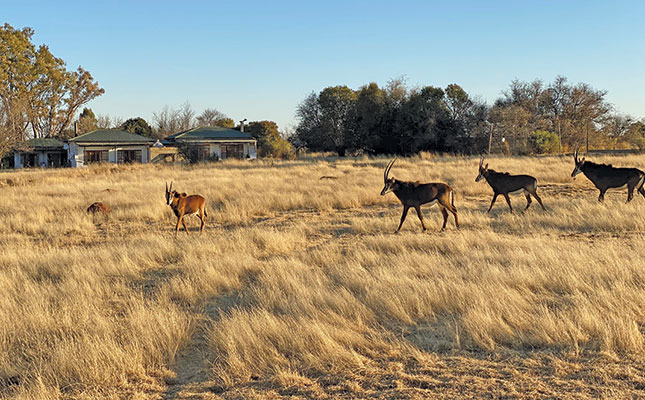We’d been driving for hours without seeing anything that would interest her. It was a cold night and the shrub hares were lying low, while the spring hares were still in their borrows. I was night hunting with my crowned eagle, Ninja, in the former Lebowa, where this was legal at the time. Although it may sound like an easy way to hunt, it wasn’t. Ninja made, on average, only one kill in 10 or more flights.
Suddenly a red eye glinted faintly in the dim light of the quad bike and without hesitation Ninja launched herself into the darkness after it. I was unsure what it was, grabbed the spotlight hanging from a ring on my hunting jacket and flicked the switch on. With a shock, I realised it was a porcupine. All I could do was to shine the light on it. At the last moment she recognised it as dangerous and instead of pouncing on it, veered away and shot straight up into the air.
It took considerable time for me to locate Ninja with the spotlight where she soared in total darkness, high above the treetops. Shining the spotlight on myself and especially on my outstretched arm, I called to her. Like a parachute, she slowly descended and landed softly on my glove. Ninja had never seen a porcupine before, but being able to read the sign language of the wild she realised it was dangerous and instinctively knew she had to avoid it.
Outdoor and field sports people should also recognise these signs and avoid creatures displaying them. There are many examples of creatures that warn you beforehand not to mess with them, because they’re either venomous or poisonous or have a bad attitude. It must be noted that the terms “poisonous” and “venomous” are not the same. A poisonous animal is one that will either kill you or make you sick when you eat it, while a venomous one has a sting or bite that injects venom into you.
The warning signs are universal and all based on colour. Black is almost always found in combination with one or more of either yellow, white or red. These colours are most often used in alternating bands, the most familiar being insects like bees and wasps of which the honeybee is a classic example. However, not all warnings are genuine. Some creatures are merely bluffing to avoid predation. Many harmless flies including hover and drone flies so closely mimic honeybees most people give them a wide berth.
Some butterflies, like the African Monarchs, are black and white combined with reddish-brown to advertise they’re extremely unpalatable, and they’re also mimicked by a host of very similar, but sweet-tasting, species. A young bird that tries to eat a monarch will never touch one of the similar but palatable species again. Black and yellow tiger beetles or oogpisters can bite fiercely and produce a quite nasty chemical spray, while the highly toxic cantharidin secretion of the CMR beetles causes blisters on the skin and can be fatal if swallowed.
Recently, I was bitten on the finger by a small black and reddish-brown assassin bug. It caused excruciating pain for days and eventually the finger turned almost black. Now, after two weeks, it’s still numb and in some species the effect can last for months. There are almost 500 local species of assassin bugs, which all display some warning colours. Although dangerous, they’re ruthless predators of millipedes and other insects and should not be killed, but outdoor people and farmers should acquaint themselves with them and avoid them at all cost.
Many spiders display the classic warning colours in different combinations and sometimes have very decorative patterns. The very dangerous black widow spider is black with a red line along the top of its abdomen. Although toads have poison glands, they’re readily eaten by snakes, but one frog they won’t touch, and whose poisonous skin secretions will even kill other frogs that come into contact with it, is the banded rubber frog.
We have no dangerous lizards but several venomous snakes use colour as a warning, while some harmless ones use colour, but are just bluffing. Most mammals can’t distinguish colour and have stark bands of black and white to deliver their message. Apart from porcupines, the skunks, polecats, civets, genets and honey badgers all advertise that if you mess with them, you will be in for a nasty surprise.
Even humans use the same coloured sign language. For many years, warning chevrons were compulsory on trucks and trailers and lately yellow and black adhesive tape is used. Black and yellow or red chevrons are extensively used as warning signals on road signs, but the high death toll on our roads suggests that many drivers are not only illiterate, but unable to read simple sign language.
Contact Abré J Steyn on 083 235 4822 or e-mail [email protected].












